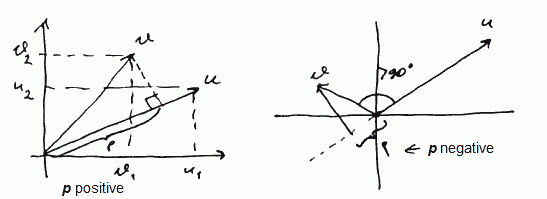Dot Product
Geometric Definition
Let $\vec v \cdot \vec w$ denote the ‘‘dot product’’ between vectors $\vec v$ and $\vec w$
-
definition: $\vec v \cdot \vec w = | \vec v | \cdot | \vec w | \cdot \cos \theta$ where $\theta$ is the angle between $\vec v$ and $\vec w$ - $| \vec v |$ denotes the length of $\vec v$ - if two vectors are perpendicular, then $\cos \theta = 0$ and thus $\vec v \cdot \vec w = 0$ - if they co-directional, then $\theta = 0$ and $\vec v \cdot \vec w = | \vec v | \cdot | \vec w |$ |- consequently, we have $\vec v \cdot \vec v = | \vec v |^2$ |

Projections
Dot product is a projection:
-
let’s project $\vec v$ onto $\vec w$: $\text{proj}_{\vec w} (\vec v) = | \vec v | \cos \theta$ (by the $\cos$ definition) - we’re interested only in the direction of $\vec w$, so let’s normalize it to get $\hat w = \vec w / | \vec w |$ - it’s the unit vector in the direction $\vec w$ - $\vec v \cdot \hat w$ - dot product of $\vec v$ and some unit vector -
$\vec v \cdot \hat w = | \hat w | | \vec v | \cos \theta = | \vec v | \cos \theta$ - it is a projection in the direction of $\vec w$
-
- so $\vec v \cdot \hat w$ corresponds to the projection of $\vec v$ onto $\vec w$
-
$\text{proj}_{\vec w} (\vec v) = \vec v \cdot \hat w = | \vec v | \cos \theta$ - is the length of this projection - thus, $\vec v \cdot \vec w = | \vec v | | \vec w | \cos \theta = | \vec w | \cdot \text{proj}{\vec w} (\vec v) = | \vec v | \cdot \text{proj}{\vec v} (\vec w)$
$p = \text{proj}_{\vec u} (\vec v) = \vec v \cdot \hat u = | \vec v | \cos \theta$ |- it can be positive or negative
- positive when angle between vectors is less than $90^o$
- negative when angle between vectors is greater than $90^o$

The Cosine Theorem
Why does this geometric definition make sense?
- consider vectors $\vec u$, $\vec v$ and $\vec w$
- let $\vec v + \vec u = \vec w$ or $\vec u = \vec w - \vec v$

-
$| \vec u |^2 = | \vec w - \vec v |^2 = (\vec w - \vec v) \cdot (\vec w - \vec v) = | \vec w |^2 + | \vec v |^2 - 2 \cdot \vec w \vec v$ - by the Cosine Theorem we know that -
$| \vec u |^2 = | \vec w - \vec v |^2 = | \vec w |^2 + | \vec v |^2 - 2 \cdot | \vec w | \cdot | \vec v | \cdot \cos \theta$ - so $| \vec w | \cdot | \vec v | \cdot \cos \theta = \cfrac{1}{2} (| \vec w |^2 + | \vec v |^2 - | \vec w - \vec v |^2) = \cfrac{1}{2} (| \vec w |^2 + | \vec v |^2 - | \vec w |^2 - | \vec v |^2 + 2 \cdot \vec w \vec v) = \vec w \cdot \vec v$ - thus $\vec w \cdot \vec v = | \vec w | \cdot | \vec v | \cdot \cos \theta$ - i.e. the definition makes sense from the The Cosine Theorem point of view
-
Algebraic Definition
For two vectors $\mathbf v, \mathbf w \in \mathbb R^n$ we define the dot product as $\mathbf v^T \mathbf w = \sum\limits_{i = 1}^n v_i w_i$
Vector Orthogonality
$\mathbf v \; \bot \; \mathbf w \iff \mathbf v^T \mathbf w = 0$
Why?
-
by the Pythagoras theorem: $| \mathbf v |^2 + | \mathbf w |^2 = | \mathbf v + \mathbf w |^2$ - $\mathbf v^T \mathbf v + \mathbf w^T \mathbf w = (\mathbf v + \mathbf w)^T (\mathbf v + \mathbf w) = \mathbf v^T \mathbf v + \mathbf v^T \mathbf w + \mathbf w^T \mathbf v + \mathbf w^T \mathbf w$ - or $\mathbf v^T \mathbf w + \mathbf w^T \mathbf v = 0$
- note that $\mathbf v^T \mathbf w = \mathbf w^T \mathbf v$, so we have
- $2 \mathbf v^T \mathbf w = 0$ or $\mathbf v^T \mathbf w = 0$
Equivalence of Definitions
Both definitions are equivalent.
I.e. $\vec v \cdot \vec w = \mathbf v^T \mathbf w = | \vec v | | \vec w | \cos \theta = \sum\limits_{i = 1}^n v_i w_i$ | Why?
- let $\vec e_1, \ … \ , \vec e_n$ be the standard basis in $\mathbb R^n$
- these vectors are orthonormal, i.e. $\vec e_i \cdot \vec e_j = \begin{cases}
1 & \text{if } i = j
0 & \text{if } i \ne j
\end{cases}$ -
let’s consider a dot product $\vec v \cdot \vec e_i$: $\vec v \cdot \vec e_i = | \vec v | \cos \theta = v_i$ - it’s a projection of $\vec v$ onto $ \vec e_i$ - which is $i$th component of $\vec v$ - we can project $\vec v$ and $\vec w$ onto the entire basis and get - $\vec v = \sum\limits_{i = 1}^n v_i \cdot \vec e_i$ and $\vec w = \sum\limits_{i = 1}^n w_i \cdot \vec e_i$
- So, $\vec v \cdot \vec w = \vec v \cdot \sum\limits_{i = 1}^n w_i \vec e_i = \sum\limits_{i = 1}^n w_i (\vec v \cdot \vec e_i) = \sum\limits_{i = 1}^n v_i w_i$
$\square$
Sources
- Linear Algebra MIT 18.06 (OCW)
- Machine Learning (coursera)
- http://en.wikipedia.org/wiki/Dot_product
- http://math.oregonstate.edu/bridge/papers/dot+cross.pdf
- http://en.wikipedia.org/wiki/Law_of_cosines